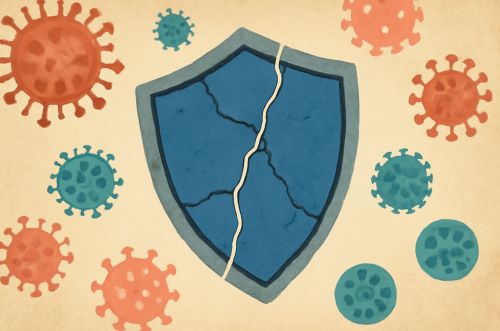

The moment we believe the war is won, the pathogens remind us that it never truly ends; it only pauses, waiting for us to let down our guard.

By Matthew A. McIntosh
Public Historian
Brewminate
The Illusion of Eradication
For much of the late twentieth century, the industrialized world seemed to write a triumphant chapter in the book of public health. Vaccines were the heroes, and diseases like measles, rubella, and polio had been cast as the vanquished villains. Measles deaths plummeted globally by 73 percent between 2000 and 2018, while polio, once a specter haunting every summer, was nearly eradicated thanks to decades of relentless immunization campaigns. Rubella, which causes devastating congenital defects, had been pushed so far into the margins of medical concern that many younger physicians had never even seen a case.
And yet, the shield is cracking.
A growing constellation of outbreaks in regions once considered secure points to a slow unraveling. These diseases, once managed, tamed, and even celebrated as defeated, are back. They are not roaring, not yet, but they are gathering.
In 2023, the World Health Organization reported more than 30,000 cases of measles globally, a sharp increase from the pandemic lows in 2020. Rubella outbreaks, though smaller in scale, reemerged in Southeast Asia and parts of Eastern Europe. And polio, long held in check by oral and injectable vaccines, surfaced in places like London and New York with traces detected in wastewater, a silent warning from the underworld of infrastructure.
A Crisis of Confidence
The comeback of these preventable diseases is not due to biology. It is, in many respects, a human failure.
At the center of the problem lies a crisis of confidence in vaccination. That crisis has roots that predate COVID-19, but the pandemic supercharged it with new potency. Trust in public health institutions, never monolithic to begin with, fractured under the strain of lockdowns, shifting guidance, and a politicized discourse around personal liberty.
Measles requires extraordinarily high vaccination coverage to maintain herd immunity, around 95 percent. In some areas of the United States, that number has dropped well below. A 2024 CDC report showed that kindergarten vaccine coverage nationwide had slipped to 93 percent, with some states like Idaho and Texas seeing rates closer to 85 percent in certain counties. These may sound like minor dips, but measles is not a minor threat. It is one of the most contagious pathogens on Earth, capable of infecting 90 percent of susceptible individuals in close contact.
This pattern repeats globally. In 2022, the Democratic Republic of Congo experienced over 100,000 suspected measles cases and more than 1,800 deaths. These were not numbers from a century ago. They were from last year.
The resistance is not always ideological. In conflict zones or under-resourced regions, vaccines may simply be unavailable or logistically impossible to distribute. But in wealthier nations, refusal, – or at best, hesitancy – is often born of distrust rather than access.
Cultural Memory and the Vanishing Threat

One reason these diseases are returning is also the most tragic. We forgot how bad they were.
Polio is often remembered now in grainy black-and-white footage. Iron lungs and crutches evoke a bygone era, not an ongoing risk. Rubella’s dangers are invisible until birth defects appear. Measles, once a childhood rite of passage, was recast as harmless by contrarian voices online who blurred the line between anecdote and evidence.
Public health depends not only on science, but on memory. And in societies where the most devastating epidemics have passed into myth, the urgency to prevent their return falters. In a 2022 Pew survey, only 63 percent of Americans aged 18–29 viewed childhood vaccines as “very important.” That number had been 76 percent just six years earlier.
The result is a generational erosion of the very foundation that made vaccine-driven triumphs possible. The longer we go without mass outbreaks, the less incentive there seems to be to prevent them. The success of the past is now one of the greatest risks to the future.
Rubella and the Hidden Toll
Rubella has long been overshadowed by its louder, more immediate cousins. It rarely causes severe illness in children or adults. But when contracted during pregnancy, particularly in the first trimester, the consequences can be catastrophic. Congenital Rubella Syndrome (CRS) can lead to deafness, blindness, intellectual disability, and heart defects in newborns.
In 2023, Japan, which had previously controlled rubella through a gendered and incomplete vaccination policy, saw a reemergence of the virus among men aged 30–50. These were adults who had never been targeted by the national immunization program during childhood. They carried it unknowingly, passing the virus along until it found its way to the most vulnerable: pregnant women without immunity.
This is the danger of selective memory and selective policy. Immunization must be comprehensive to be effective. Piecemeal approaches, even in developed nations, create the cracks through which resurgence flows.
The Polio Paradox

Polio’s return is perhaps the most surreal of all. Not through natural outbreak, but through a bitter paradox of the very tool that helped contain it: the oral polio vaccine (OPV). Unlike the injectable inactivated version (IPV), OPV uses a weakened live virus that can, in rare cases, mutate and circulate in under-vaccinated communities. This is called circulating vaccine-derived poliovirus (cVDPV), and it is not a hypothetical concern. In 2022, over 800 cases were reported globally, with the majority in Africa and parts of Asia.
The reappearance of polio in wastewater samples in London and New York in recent years reflects a similar concern: small viral reintroductions, amplified by gaps in community immunity. These are not just relics. They are warnings.
Public Health in a Fractured World
The response to these resurgent threats is uneven. The WHO has launched renewed initiatives to close immunization gaps, particularly through its Immunization Agenda 2030. Organizations like Gavi and UNICEF continue to play a crucial role in distributing vaccines to low-income nations. But the challenge is no longer just supply. It is belief. It is stability. It is geopolitics.
War and displacement are creating vast populations of children without consistent medical care. In Sudan, civil conflict has halted routine vaccination in several regions entirely. In Afghanistan and Pakistan, the last strongholds of endemic polio, Taliban resistance to vaccination continues to jeopardize eradication efforts.
In the United States, misinformation on social media continues to outpace public health campaigns. YouTube videos and TikTok influencers often reach more eyes than CDC briefings. Some parents are convinced they are protecting their children by refusing vaccines. Others remain unsure, paralyzed by the volume of conflicting voices.
Toward a Harder Hope
Hope, if it is to be honest, cannot be easy.
It will take more than science to rebuild a sense of civic health. Public trust must be re-earned, not assumed. Health communication must adapt to a fragmented digital world. Local leaders, not just national institutions, will need to speak with credibility, compassion, and clarity.
The diseases that once stalked our world have not changed. Measles is still measles. Rubella still quietly threatens pregnancies. Polio still waits in the shadows of global transit systems and sewage channels.
What has changed is us.
And so, the task is not just medical. It is moral. It is collective. It requires memory. It requires vigilance. Above all, it requires a humility that understands progress is not a destination, but a direction. The moment we believe the war is won, the pathogens remind us that it never truly ends; it only pauses, waiting for us to let down our guard. And lately, we have.
Originally published by Brewminate, 07.21.2025, under the terms of a Creative Commons Attribution-NonCommercial-NoDerivatives 4.0 International license.


